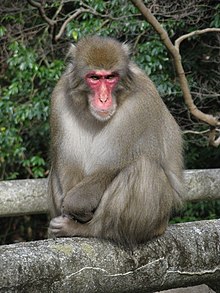Macaca fuscata
| Japanese macaque | |
|---|---|
 |
|
| Scientific classification | |
| Kingdom: | Animalia |
| Phylum: | Chordata |
| Class: | Mammalia |
| Order: | Primates |
| Family: | Cercopithecidae |
| Genus: | Macaca |
| Species: | M. fuscata |
| Binomial name | |
|
Macaca fuscata Blyth, 1875 |
|
| Subspecies | |
|
Macaca fuscata fuscata |
|
 |
|
| Japanese macaque range | |
Macaca fuscata fuscata
Macaca fuscata yakui
The Japanese macaque (/məˈkɑːk/;Macaca fuscata), also known as the snow monkey, is a terrestrial Old World monkey species that is native to Japan. They get their name "snow monkey" because they live in areas where snow covers the ground for months each year – no other nonhuman primate is more northern-living, nor lives in a colder climate. Individuals have brown-grey fur, red faces, and short tails. Two subspecies are known.
In Japan, the species is known as Nihonzaru (Nihon 日本 "Japan" + saru 猿 "monkey") to distinguish it from other primates, but the Japanese macaque is very familiar in Japan, so when Japanese people simply say saru, they usually have in mind the Japanese macaque.
The Japanese macaque is sexually dimorphic. Males weigh on average 11.3 kg (25 lb), while females average 8.4 kg (19 lb). Macaques from colder areas tend to weigh more than ones from warmer areas. Male average height is 570.1 mm (22.44 in) and female average height is 522.8 mm (20.58 in). Their brain size is about 95 g (3.4 oz). Japanese macaques have short stumps for tails that average 92.51 mm (3.642 in) in males and 79.08 mm (3.113 in) in females. The macaque has a pinkish face and posterior. The rest of its body is covered in brown or greyish hair. The coat of the macaque is well-adapted to the cold and its thickness increases as temperatures decrease. The macaque can cope with temperatures as low as -20 °C (-4 °F).
Macaques mostly move on all fours. They are semiterrestrial, with females spending more time in the trees and males spending more time on the ground. Macaques are known to leap. They are also great swimmers and have been reported to swim over half a kilometer. The longevity for the macaque averages 6.3 years (at least for females). However, they have been known to live much longer; males have lived up to 28 years and females up to 32 years.
Japanese macaques live in matrilineal societies, and females stay in their natal groups for life, while males move out before they are sexually mature. Macaque groups tend to contain a number of adults of both sexes. In addition, a macaque troop contains several matrilines. These matrilines may exist in a dominance hierarchy with all members of a specific group ranking over members of a lower-ranking group. Temporary all-male groups also exist, composed of those that have recently left their natal groups and are about to transfer to another group. However, many males spend ample time away from any group and may leave and join several groups.
...
Wikipedia

